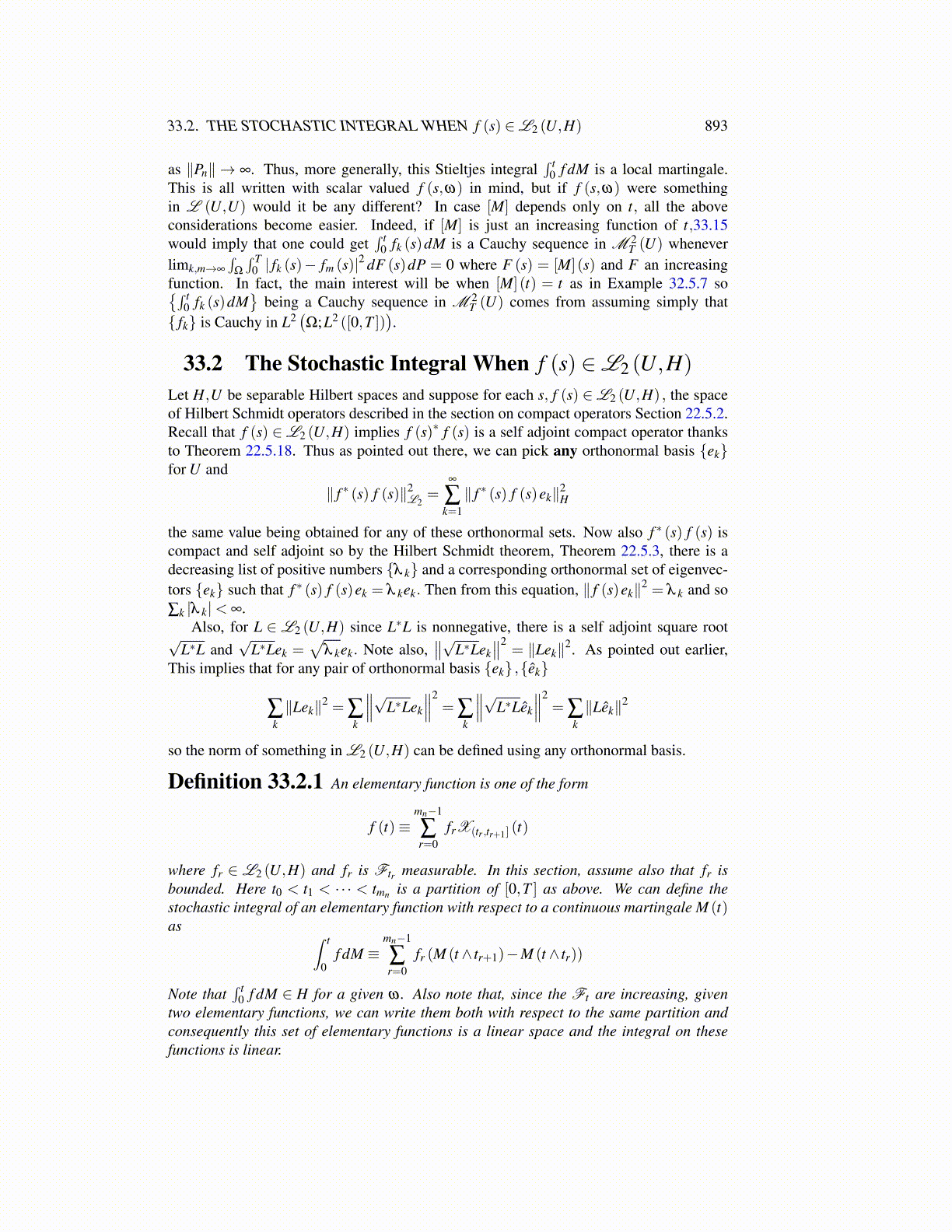
33.2. THE STOCHASTIC INTEGRAL WHEN f (s) ∈L2 (U,H) 893
as ∥Pn∥ → ∞. Thus, more generally, this Stieltjes integral∫ t
0 f dM is a local martingale.This is all written with scalar valued f (s,ω) in mind, but if f (s,ω) were somethingin L (U,U) would it be any different? In case [M] depends only on t, all the aboveconsiderations become easier. Indeed, if [M] is just an increasing function of t,33.15would imply that one could get
∫ t0 fk (s)dM is a Cauchy sequence in M 2
T (U) wheneverlimk,m→∞
∫Ω
∫ T0 | fk (s)− fm (s)|2 dF (s)dP = 0 where F (s) = [M] (s) and F an increasing
function. In fact, the main interest will be when [M] (t) = t as in Example 32.5.7 so{∫ t0 fk (s)dM
}being a Cauchy sequence in M 2
T (U) comes from assuming simply that{ fk} is Cauchy in L2
(Ω;L2 ([0,T ])
).
33.2 The Stochastic Integral When f (s) ∈L2 (U,H)
Let H,U be separable Hilbert spaces and suppose for each s, f (s) ∈L2 (U,H) , the spaceof Hilbert Schmidt operators described in the section on compact operators Section 22.5.2.Recall that f (s) ∈L2 (U,H) implies f (s)∗ f (s) is a self adjoint compact operator thanksto Theorem 22.5.18. Thus as pointed out there, we can pick any orthonormal basis {ek}for U and
∥ f ∗ (s) f (s)∥2L2
=∞
∑k=1∥ f ∗ (s) f (s)ek∥2
H
the same value being obtained for any of these orthonormal sets. Now also f ∗ (s) f (s) iscompact and self adjoint so by the Hilbert Schmidt theorem, Theorem 22.5.3, there is adecreasing list of positive numbers {λ k} and a corresponding orthonormal set of eigenvec-tors {ek} such that f ∗ (s) f (s)ek = λ kek. Then from this equation, ∥ f (s)ek∥2 = λ k and so∑k |λ k|< ∞.
Also, for L ∈ L2 (U,H) since L∗L is nonnegative, there is a self adjoint square root√L∗L and
√L∗Lek =
√λ kek. Note also,
∥∥√L∗Lek∥∥2
= ∥Lek∥2. As pointed out earlier,This implies that for any pair of orthonormal basis {ek} ,{êk}
∑k∥Lek∥2 = ∑
k
∥∥∥√L∗Lek
∥∥∥2= ∑
k
∥∥∥√L∗Lêk
∥∥∥2= ∑
k∥Lêk∥2
so the norm of something in L2 (U,H) can be defined using any orthonormal basis.
Definition 33.2.1 An elementary function is one of the form
f (t)≡mn−1
∑r=0
frX(tr ,tr+1] (t)
where fr ∈ L2 (U,H) and fr is Ftr measurable. In this section, assume also that fr isbounded. Here t0 < t1 < · · · < tmn is a partition of [0,T ] as above. We can define thestochastic integral of an elementary function with respect to a continuous martingale M (t)as ∫ t
0f dM ≡
mn−1
∑r=0
fr (M (t ∧ tr+1)−M (t ∧ tr))
Note that∫ t
0 f dM ∈ H for a given ω . Also note that, since the Ft are increasing, giventwo elementary functions, we can write them both with respect to the same partition andconsequently this set of elementary functions is a linear space and the integral on thesefunctions is linear.